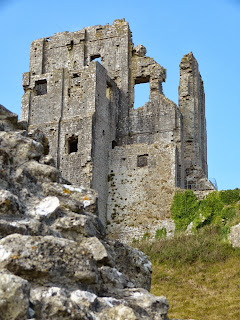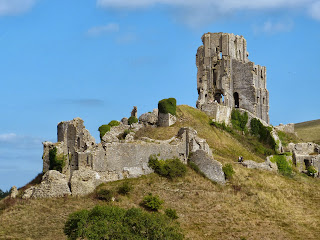Corfe Castle is in the village of the same name near Wareham in Dorset.
History
Corfe Castle was built for William the Conqueror around 1086 and during the early 1200s it was a favourite fortress of King John. It remained a royal residence until 1572 when Queen Elizabeth I sold it to Sir Christopher Hatton, who later became the Lord Chancellor.
History
Corfe Castle was built for William the Conqueror around 1086 and during the early 1200s it was a favourite fortress of King John. It remained a royal residence until 1572 when Queen Elizabeth I sold it to Sir Christopher Hatton, who later became the Lord Chancellor.
 |
| Lady Bankes from The Story of Corfe Castle by G Bankes (1853) |
In 1635, the castle was purchased by Sir John Bankes, the Lord Chief Justice, and it was defended by his wife, Lady Bankes, on behalf of the King during the Civil War. The castle held out against a siege by the Parliamentarians in 1643 and was only defeated during a second siege by the betrayal of one of Lady Bankes’s own officers.
 |
| Keys of Corfe Castle on display at Kingston Lacy(2013) |
In recognition of her bravery, Lady Bankes – “Brave Dame Mary” – was allowed to keep the castle keys.1 Parliament voted for the castle’s demolition and it was destroyed by explosives in 1646, creating the ruin that remains today.
The Bankes family built a new home at Kingston Lacy and this was given to the National Trust, along with Corfe Castle, in 1981.
The Bankes family built a new home at Kingston Lacy and this was given to the National Trust, along with Corfe Castle, in 1981.
Georgian connection
 |
| Corfe Castle from The Lady's Magazine (1789) |
The romantic ruin of Corfe Castle was a popular visitor attraction in the Georgian period. It is mentioned in the local guidebooks of the time.
The Weymouth Guide (1785) describes Corfe Castle as “one of the finest ruins in Europe.”2
The Weymouth and Melcombe Regis New Guide (1835) states:
The vast fragments of the king’s tower, the round tower leaning as if ready to fall, the broken walls, and the huge mass hurled into the vale below, form such as scene of havoc and devastation, as must strike the spectator at once with horror and regret.3
 |
| Corfe Castle (2012) |
A guidebook from 1857 gives a short history of the castle and then concludes:
We recount these deeds to show the spirit and conduct of times happily passed away. These beautiful ruins bear not the guilt of those perpetrations; and in them, it may be, is set forth a moral lesson, safe to learn and good to practise: hence, in contemplating the ruins of Corfe Castle, we may realize that there are ‘sermons in stones, & c.’4
 |
| Corfe Castle (2013) |
• A ruined castle!
 |
| Corfe Castle (2013) |
 |
| View from Corfe Castle (2013) |
Rachel Knowles writes clean/Christian Regency era romance and historical non-fiction. She has been sharing her research on this blog since 2011. Rachel lives in the beautiful Georgian seaside town of Weymouth, Dorset, on the south coast of England, with her husband, Andrew.
Find out more about Rachel's books and sign up for her newsletter here.If you have enjoyed this blog and want to encourage me and help me to keep making my research freely available, please buy me a virtual cup of coffee by clicking the button below.
Notes
1. The keys of Corfe Castle are on display at Kingston Lacy.
2. The Weymouth Guide (1785).
3. The Weymouth and Melcombe Regis New Guide (1835).
4. Weymouth as a Watering Place (1857).
Sources used include:2. The Weymouth Guide (1785).
3. The Weymouth and Melcombe Regis New Guide (1835).
4. Weymouth as a Watering Place (1857).
Bankes, George, The Story of Corfe Castle, and of Many who Have Lived There (1853)
Delamotte, Peter, The Weymouth Guide (1785, Weymouth)
Groves, E, The Weymouth and Melcombe Regis New Guide (E Groves, 1835, Weymouth)
Simpkin & Marshall, Weymouth as a Watering Place (Simpkin & Marshall, 1857, London)
The Lady's Magazine (1789)
The National Trust, Corfe Castle (guidebook) (1985)
Delamotte, Peter, The Weymouth Guide (1785, Weymouth)
Groves, E, The Weymouth and Melcombe Regis New Guide (E Groves, 1835, Weymouth)
Simpkin & Marshall, Weymouth as a Watering Place (Simpkin & Marshall, 1857, London)
The Lady's Magazine (1789)
The National Trust, Corfe Castle (guidebook) (1985)
Photographs © RegencyHistory



No comments:
New comments are not allowed.